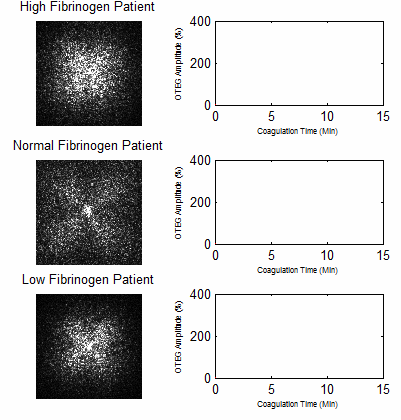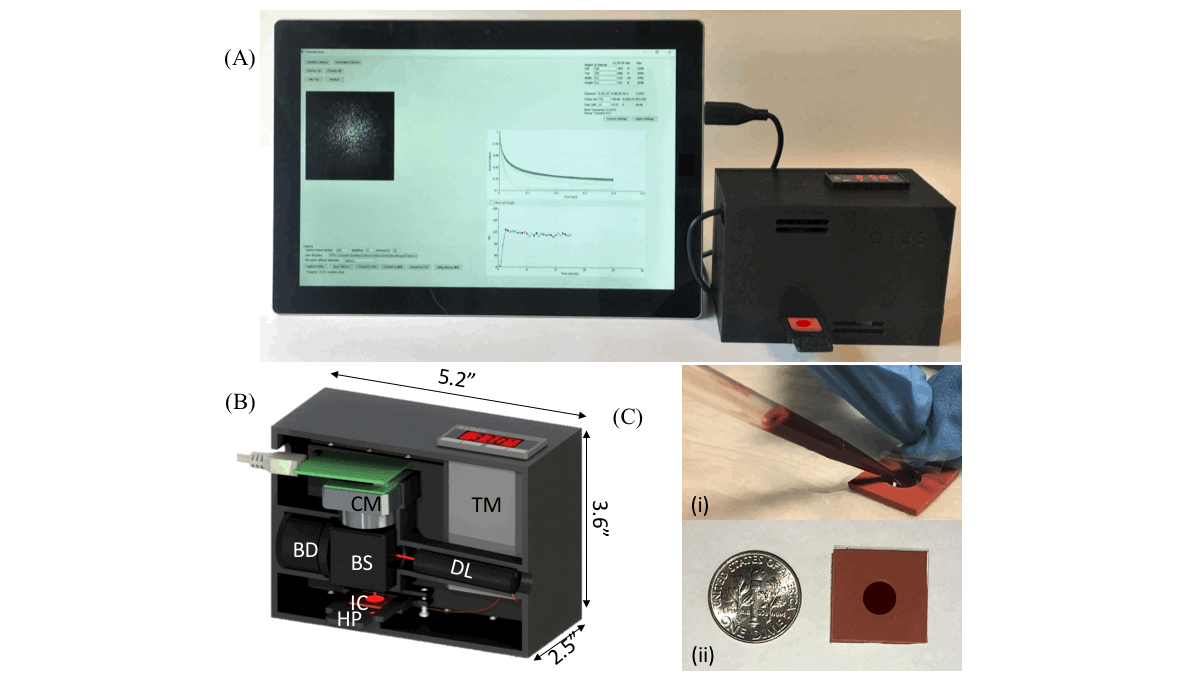Our laboratory has developed a low-cost, multi-functional blood coagulation sensor that can measure a patient’s coagulation status within less than 5 minutes using a single drop of whole blood. This hand-held sensor addresses the critical unmet need to identify and manage patients with an elevated risk of life-threatening bleeding or hemorrhage, the major cause of in-hospital preventable death. In addition, this innovation will enable rapid coagulation testing in the home or primary care setting for over 15 million patients worldwide who routinely receive oral anticoagulants to prevent venous and arterial thrombosis, the world’s number one killer. Coagulation testing at the point of care is currently the fastest growing segment of the in vitro blood diagnostics market, with nearly $2 billion in global annual sales. Driven by the immediate need for improved blood product utilization and the rapidly growing numbers of patients receiving anti-coagulants worldwide, the need for comprehensive coagulation testing industry is expected to burgeon over the next decade. Currently, a battery of conventional coagulation tests (CCTs) are performed to assess several relevant parameters: clotting time, clot rate, fibrinogen, fibrinolysis and platelet function, to reveal the underlying cause of bleeding. Unfortunately, it takes several hours before tests results are available, rendering CCTs unreliable, particularly in the context of critically-ill patients. Our coagulation sensor uniquely combines the strengths of a low-cost, hand-held module with the capability to quantify multiple relevant coagulation parameters required to diagnose the underlying coagulation defect within a fraction of the time and cost of CCTs.
Our approach, termed Optical Thromboelastography (OTEG) involves placing a drop of blood in a disposable cartridge. A laser source, similar to a common laser pointer illuminates the blood sample and a small camera images laser speckle patterns reflected from the sample over time. By analyzing laser speckle intensity fluctuations in real-time, we can measure the viscoelastic properties of blood during coagulation and recover information about multiple coagulation metrics within minutes. OTEG’s capabilities for comprehensive coagulation profiling at the bedside will likely have major clinical impact in identifying patients at high risk of bleeding or thrombosis, tailoring blood transfusion and anti-coagulation protocols, and monitoring hemostasis during therapy to improve patient outcome.

Laser speckle patterns and the corresponding changes in clot stiffness are measured in three patients with normal, low and high fibrinogen. The capability to form stable fibrin clots depends in part on the amount of fibrinogen, a soluble protein in plasma. Therefore, low levels of fibrinogen impairs clot stiffness, and is potentially a risk factor for severe bleeding. In contrast, patients with high serum fibrinogen have stiffer clots, that likely contribute to thrombotic events.
Photograph of the hand-held sensor, compatible with a Window surface tablet for real-time coagulation profiling in (A) with the corresponding CAD diagram of the optical and mechanical device configuration. The sensor uses a diode laser (DL) to illuminate the sample and a high-speed camera CMOS camera to collect speckle patterns during coagulation. Inexpensive test cartridges are fabricated by laser cutting a silicone base with a transparent film overlay to sample a drop of whole blood.
Relevant Publications
Clinical evaluation of whole blood prothrombin time (PT) and international normalized ratio (INR) using a Laser Speckle Rheology sensor. Tripathi MM, Egawa S, Wirth AG, Tshikudi DM, Van Cott EM, Nadkarni SK. Sci Rep. 2017 Aug 23;7(1):9169. doi: 10.1038/s41598-017-08693-5. PMID: 28835607
Optical sensing of anticoagulation status: Towards point-of-care coagulation testing. Tshikudi DM, Tripathi MM, Hajjarian Z, Van Cott EM, Nadkarni SK. PLoS One. 2017 Aug 3;12(8):e0182491. doi: 10.1371/journal.pone.0182491. eCollection 2017. PMID: 28771571
Evaluating platelet aggregation dynamics from laser speckle fluctuations. Hajjarian Z, Tshikudi DM, Nadkarni SK. Biomed Opt Express. 2017 Jun 30;8(7):3502-3515. doi: 10.1364/BOE.8.003502. eCollection 2017 Jul 1. PMID: 28717586
Estimation of particle size variations for laser speckle rheology of materials. Hajjarian Z, Nadkarni SK. Opt Lett. 2015 Mar 1;40(5):764-7. doi: 10.1364/OL.40.000764. PMID: 25723427
Optical Thromboelastography to evaluate whole blood coagulation. Hajjarian Z, Tripathi MM, Nadkarni SK. J Biophotonics. 2015 May;8(5):372-81. doi: 10.1002/jbio.201300197. Epub 2014 Apr 3. PMID: 24700701
Assessing blood coagulation status with laser speckle rheology. Tripathi MM, Hajjarian Z, Van Cott EM, Nadkarni SK. Biomed Opt Express. 2014 Feb 24;5(3):817-31. doi: 10.1364/BOE.5.000817. eCollection 2014 Mar 1. PMID: 24688816
Correction of optical absorption and scattering variations in Laser Speckle Rheology measurements. Hajjarian Z, Nadkarni SK. Opt Express. 2014 Mar 24;22(6):6349-61. doi: 10.1364/OE.22.006349. PMID: 24663983

